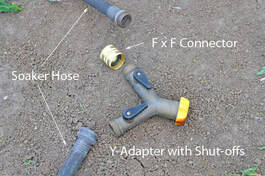
Small trees: Make sure the surrounding soil is moistened as well as the root ball to encourage roots to move out of the root ball. Soil should be moistened but not waterlogged. Water the root ball and the surrounding soil to a depth of 12 inches. This can be done in a number of ways.
- Set hose close to tree and run at a slow trickle.
- Drill a small hole near the base of a 5 gallon plastic bucket. Fill the bucket with water so that the trickle of water from the hole slowly moistens the soil.
- Use a rubber soaker hose. I usually do not recommend these because they put out different rates of water along their length. If they are coiled around the tree several times, the rates even out.
- Use a Tree Gator. This is a plastic watering bag that is placed around the tree. The bag is filled with water and slowly trickles out to water the tree.
- Drip irrigation can be used if watering a line or grouping of trees or shrubs.
Larger trees: Large trees are more often more difficult to water because the root system covers a large area. Concentrate on the area under the dripline. Though roots extend much further out than this, the greatest concentration of roots is found under the dripline.
- Sprinklers can be used if lower limbs don’t interfere with the pattern.
- Set a hose at a trickle and move when needed.
- Soaker hoses can be used but remember that the application rate varies along the length of the hose. Use a Y-Adapter to hook both the beginning and end of the soaker hose to help even out the flow. You will need a female by female fitting to connect the Y-Adapter to the end of the soaker hose.
- Drip irrigation is my favorite method because you- can make one set and water the tree. Also, the rate of application is uniform. Start at the base of the tree and spiral out to the dripline. Try to keep the tubing within 18 to 24 inches of the last spiral to make sure the entire area has been covered.
There is no set amount for how much to water because soils and application rate vary far too much. Gardeners can easily calculate how much to water for their conditions. Record the time you started watering and check the depth the water reaches periodically. When the 12-inch depth is reached, note how many minutes (or hours) were required. The depth can be checked with a metal rod such as an electric fence post, a wooden dowel or a screwdriver with a long tang. From then on, you can water on the clock. You still may want to double check because the starting soil moisture level will vary. (Ward Upham)
 RSS Feed
RSS Feed
